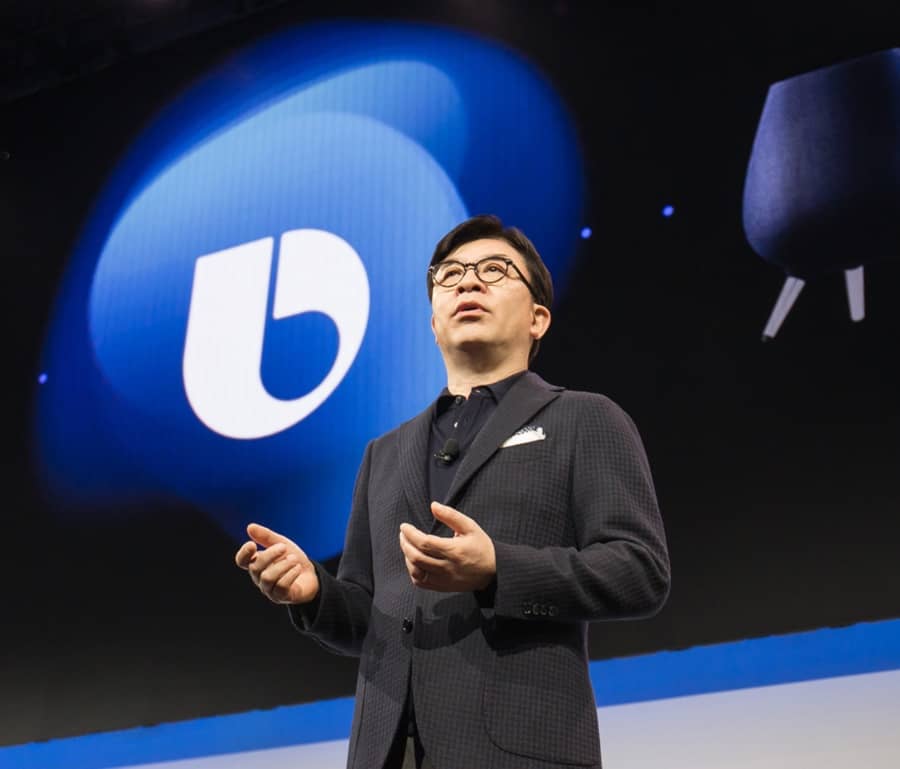
Above: Samsung’s president and CEO HS Kim presents the company’s strategy at CES. Photos courtesy Samsung.
At a press conference on Monday at CES (formerly the Consumer Electronics Show), Samsung celebrated its 50th anniversary in the technology business with a commitment to network the world through its devices more efficiently.
Opening the event (The Verge has a nine minute version here), president and CEO HS Kim noted that the South Korean company began with the manufacture of black and white television sets five decades ago and worked their way to a position of dominance and leadership in the consumer electronics industry.
“We have a bold vision for connected living, to connect the half a billion devices we sell every year.”
HS Kim, President and CEO of Samsung
“We have a bold vision for connected living,” Kim said, “to connect the half a billion devices we sell every year.”
In the US, Senior VP Yoon Lee noted, “70 percent of American homes have one Samsung device and 25 percent have at least three.”
It was a bumpy 56 minute presentation, not helped by Samsung’s decision to have a rotating cast of nine presenters, each delivering a snippet of the overall message.
Subject matter bounced around madly too, ranging from the announcement of two new laptops, the company’s role in new installations of 5G test sites in Houston and Sacramento and top-level discussions of its strategy for Internet of Things (IoT) connectivity.
Mix into that the company’s dream-state visions, which include an update to the Digital Cockpit concept dashboard that it introduced in 2018, a fully realised digital console for modern automobiles designed by subsidiary Harman.
Despite its name, CES isn’t really an event for consumers, and the general public is firmly uninvited.
It’s a gathering of the movers and shakers in the tech industry with a healthy sprinkling of startups and small technology developers each of who hopes to grab a share of an estimated trillion in US dollars spent by consumers on devices each year.
In that room at the Mandalay Bay in Las Vegas, Samsung wasn’t even talking to its peers and potential wholesale customers, the messages were for the technology press, who report across a range of interests.
So that’s why the presentation would swing wildly from statements about how the company uses data for its Artificial Intelligence initiatives (it will be governed by fairness, accountability and transparency), 98-inch 8K MicroLED televisions, and a new gaming laptop, the Odyssey, which seemed to target Alienware’s hardware.
It’s also why the company might have thought it a good idea to close the event with the deeply troubling Bot Care device, a health monitoring robot that was designed to be harmless and loveable but ended up looking quite creepy in a Chucky sort of way.
Bot Care seems to be a solution in search of a problem even for a device that’s part of an initiative that purports to be “The Future of AI companions.”
It’s an issue that also afflicts Family Hub, Samsung’s screen-based expression of the value of connected devices in the home.
In Monday’s demo, Senior VP John Herrington and Yoon Lee spent agonising minutes trying to make a use case for a large vertical touchscreen monitor on a refrigerator. It remains a hard sell.
Bixby remains at the core of its connected devices strategy and the company will be building more of its AI technologies into the software, which is front and centre on its smartphone and tablet devices.
It will also be a part of the new line of QLED televisions to be introduced in 2019.
Bixby adoption has been slow, and the company’s plans to integrate more with other concierge digital assistants like Alexa and Google Home point to a more hopeful future for the technology.
Fifty years after shipping their first tube-based television, Samsung remains on its strongest ground when it comes to their television products, which included, this year, a larger Wall, clocking in now at 219 inches.
Fifty years after shipping their first tube-based television, Samsung remains on its strongest ground when it comes to their television products, which included, this year, a larger Wall, clocking in now at 219 inches.
These new televisions will be able to access a new iTunes app for the first time on a non-Apple smart device by June 2019 and will probably be able to connect to these new screens via AirPlay 2 before that.
It’s a massive move for Apple, who have nursed a long running beef with Samsung over smartphone interface issues. For the Cupertino company, which is making tentative moves into the content creation arena, it’s equivalent to the moment that iPods became PC compatible, opening a much larger market to a company that always seems to get itself into a niche.

Key points from Samsung at CES
-
Development continues on Bixby with new services planned and connectivity with other services such as Alexa and Google Home being explored.
-
The company established seven Global AI Centers, and a new Connected Care Center uses AI to track issues with connected devices before they bloom into problems.
-
New 8K QLED televisions are available in sizes from 65” to 98”. Sales of screens larger than 75” have doubled.
-
iTunes comes to all new Samsung large screen QLED televisions in 100 countries and 2018 models will be compliant via a firmware update.
-
Samsung’s TV Plus product for their smart TVs will offer 80 free channels.
-
The NoteBook 9 Pro, an update on the 2018 laptop with an SPen enabled screen will launch in 2019 along with an updated Notebook Odyssey gaming laptop which addresses display issues, updates the CPU and GPU and adds an improved cooling system.
-
Samsung will launch its first 5G compatible smartphone in 2019.


